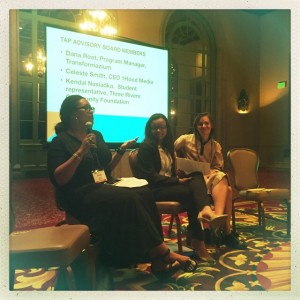2015 GIA Conference, Day 2

Tuesday morning’s IDEA LAB of artists was on point, my people.
I was particularly struck by Rosten Woo, who in a nutshell, produces communication art. Putting “interpretation” at the center of his work, he creates things like aesthetically-designed and clearly legible pamphlets on zoning so that street vendors know their rights, and glossies that highlight art and cultural occurrences in neighborhoods that, “due to racism, or the mere fact it takes place in someone’s backyard,” are not recognized as cultural staple within a community. I’m a fan.
crystal am nelson’s visual and spoken artwork was stunning, and affirming. It invokes “historical trauma combined with pleasure as complicity”, naming society’s collective involvement in the violence and de-humanization of the Black body. This is a mirror we need right now.
Over lunch, the remarkable author and thinker Claudia Rankine shared her thoughts on the work of arts funders and decision-makers in an original poem. She posed myriad questions for everyone across all identities, privileges and oppressions to consider, to take to heart, including:
- Do you ever find yourself mistaking critical response, when it is really prohibition?
- Do your race politics shape and inform the things you do?
In a session aptly entitled, “Funder, Transform Thyself,” presenters stressed that the onus of this change is on both grantors and grantees. While a clear power differential exists between the two, the Heinz Endowments Transformative Arts Process (TAP) is investing in a field building strategy that convenes advisories of young people and adults to directly influence arts opportunities and direct resources to African American youth and artists living in distressed neighborhoods. Justin Laing, the foundation’s Arts & Culture Senior Program Officer, reflected on the notion that “to be a funder is to be a gatekeeper, but how can you become a more accountable gatekeeper?” Commit to learning and undoing with the help of critical resources like The People’s Institute for Survival and Beyond – they provide solid undoing racism trainings. Also, co-design and power-share with those who will receive and use resources, contributing to a shift in the practice of program officers and foundations towards substantial change.
Furthermore, if “the arts are an essential, long-term building block of healthy, vibrant communities,” at stated by Rip Rapson, head of The Kresge Foundation, then they play a necessary role in advancing the well being of young people. Innovative arts programs such as these can inform local and national initiatives focused on supporting Black males by incorporating creativity and authentic youth partnership, while expanding the effort to include all Black youth across home language and gender.
This session also stood out for being the only one I attended that featured program staff, a community grantee and a young person.
A most surprising, and uniquely facilitated experience was found in “Game Changers: Creative Community Planning.” Participants engaged in an arts-based game termed as “embodied learning,” wherein community members are invited to explore and unpack city planning. Complex terminology that often serves to disconnect and shut down community voices is the focus of this experience. We connect experientially with concepts like zoning and affordable housing thru hands-on play with Mega Bloks. In the face of gentrification and displacement, these tools can support local residents to better advocate for themselves. Its success had garnered interest from planners interested in real community public engagement for long-term planning and visioning in urban environments. Pretty cool, and empowering.
